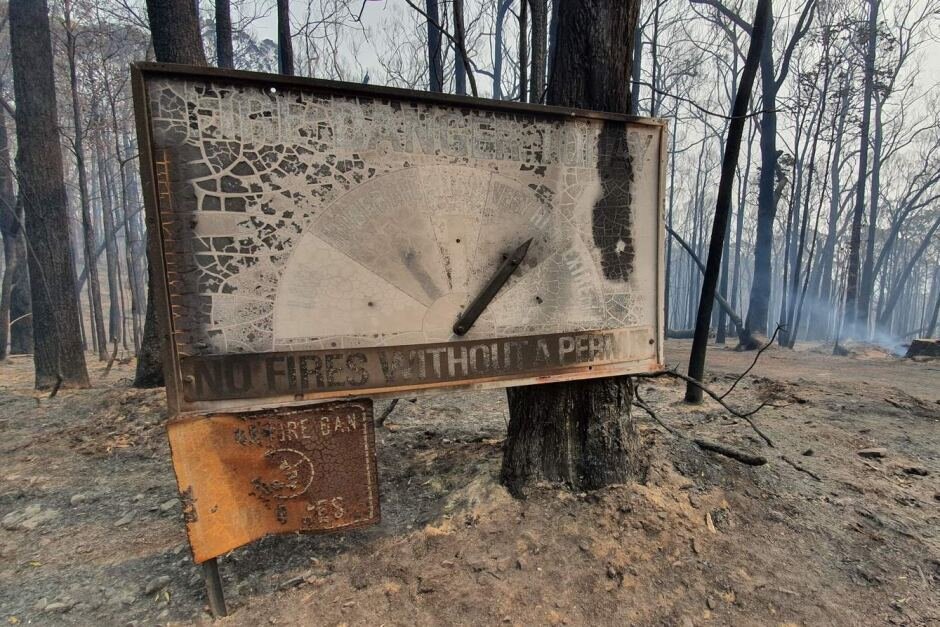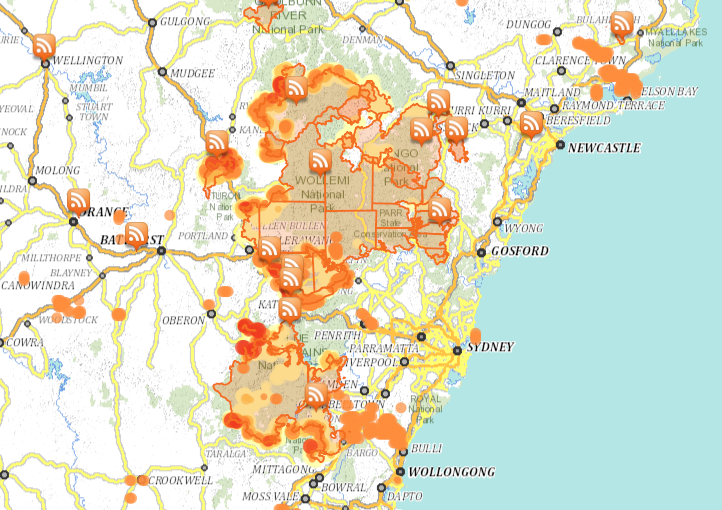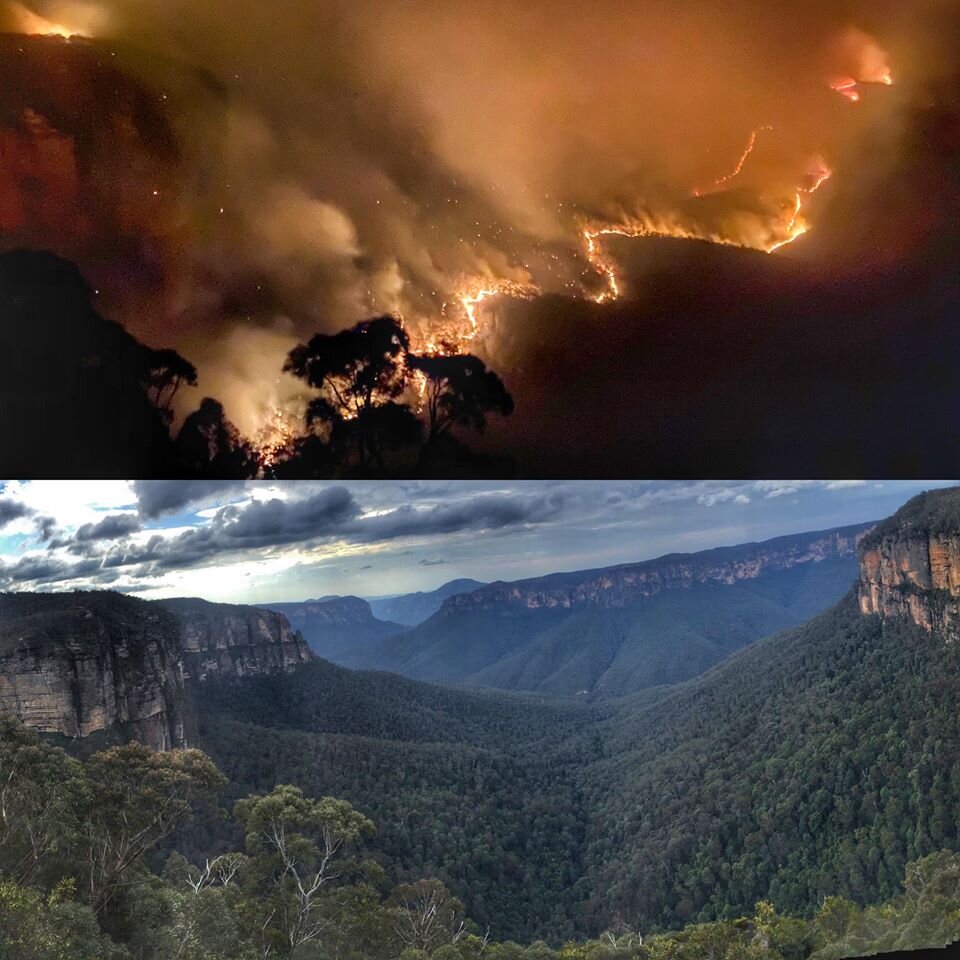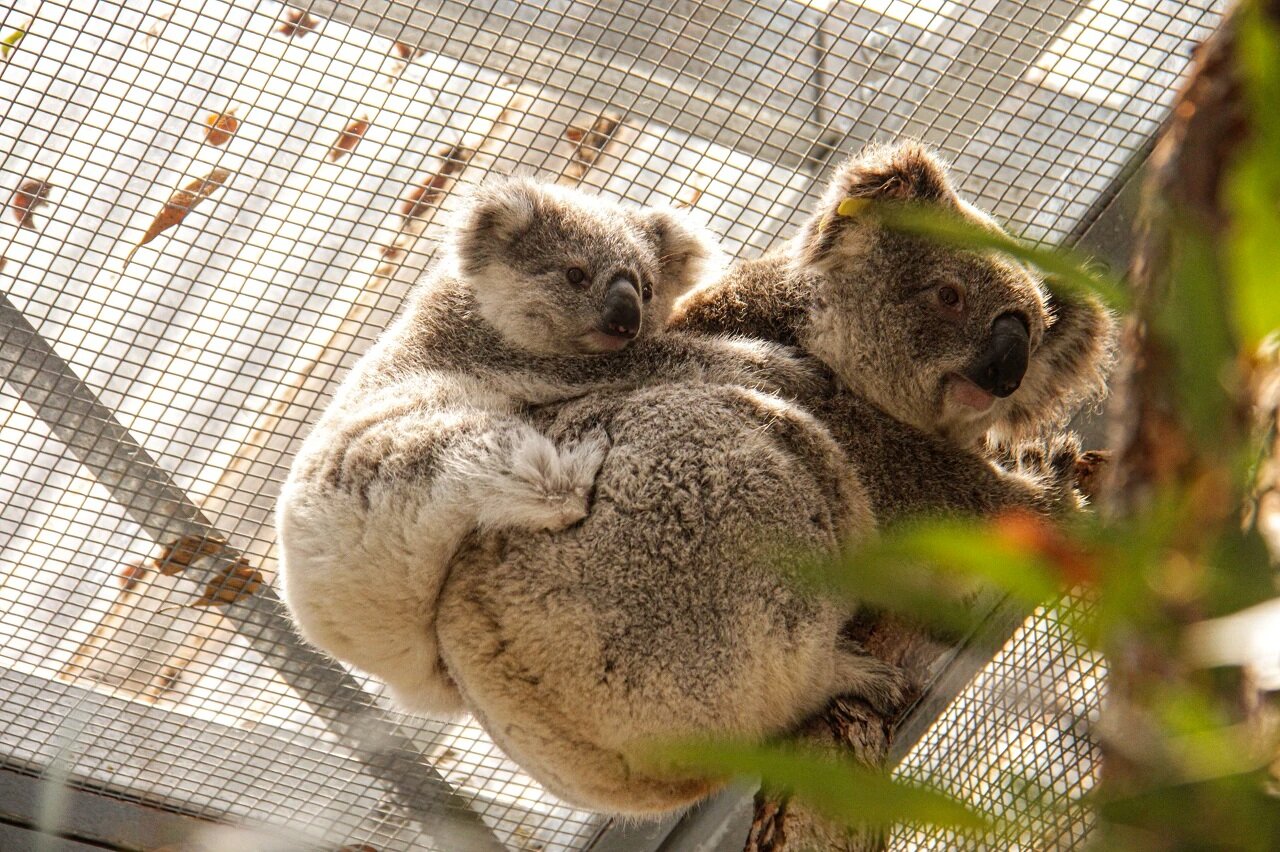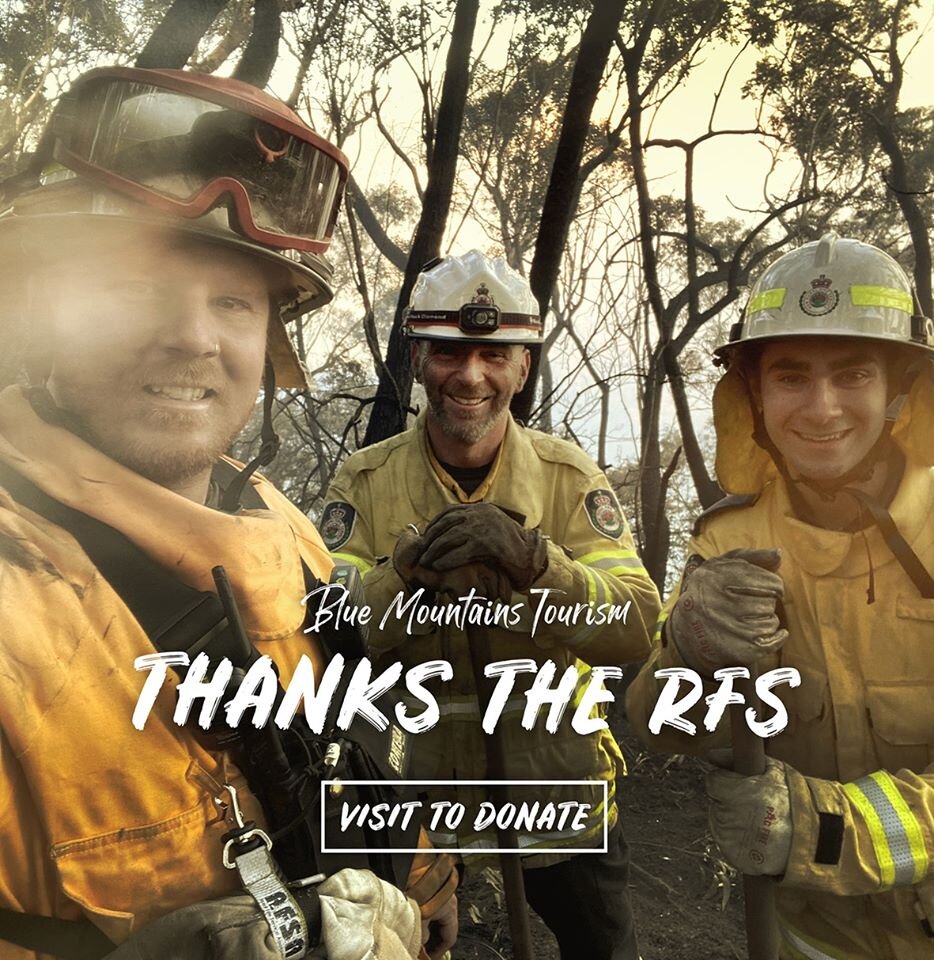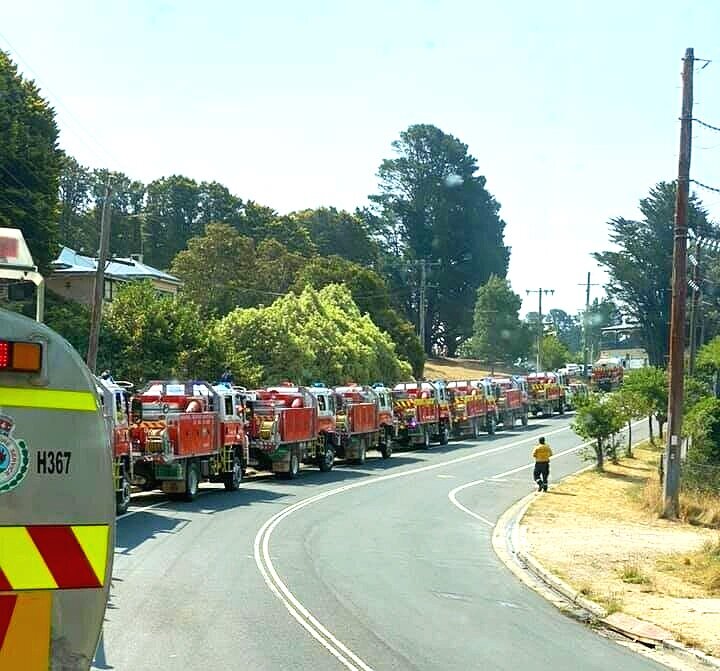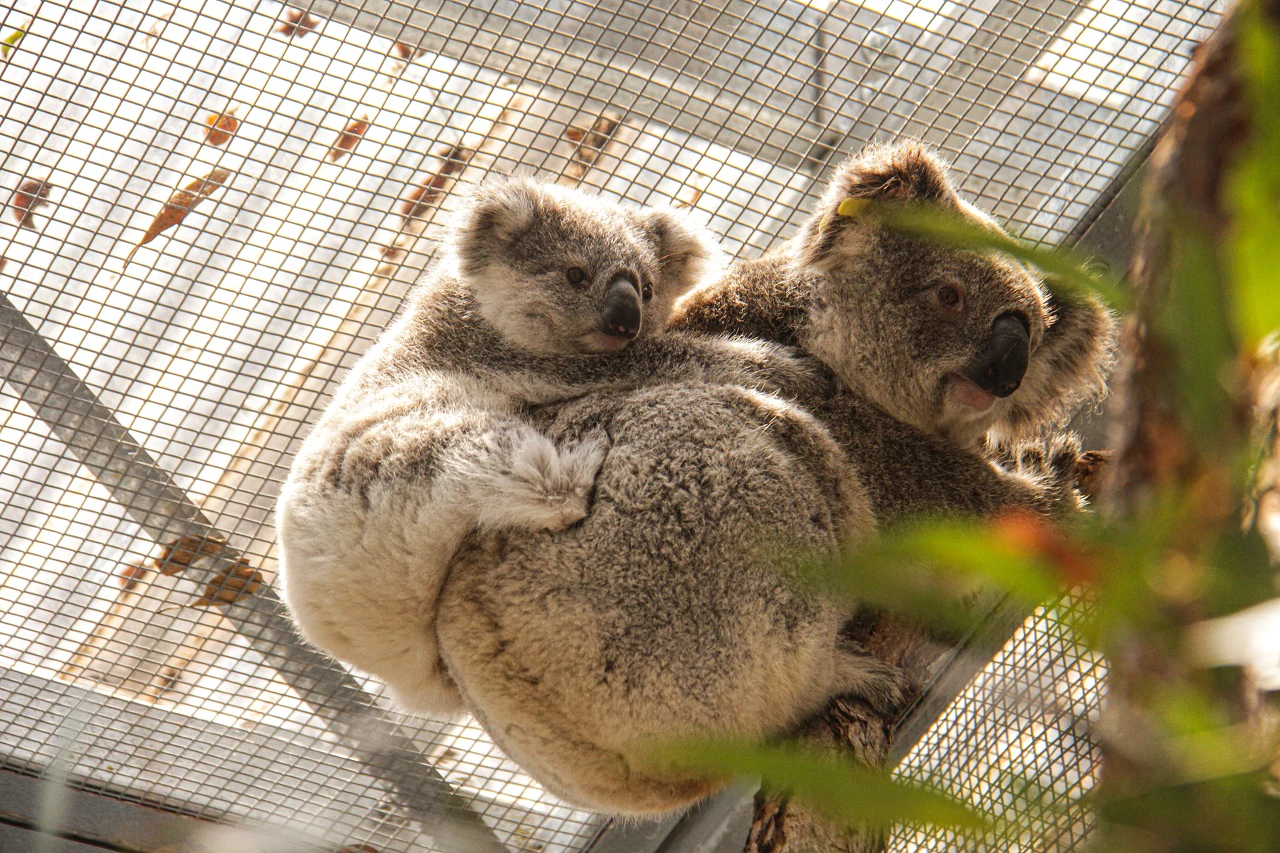We knew this was coming.
We’ve known for many years about the impacts of climate change, the danger of growing fuel loads and the increasing threat of fire. It was only a matter of when.
A burnt fire danger sign at Bilpin, NSW. Image credit: Billy Cooper, ABC News
But it’s still a shock to see enormous, out of control wildfires rage so suddenly and so powerfully, burning through hundreds of thousands of hectares of the Greater Blue Mountains World Heritage Area in a matter of days.
As we publish this, almost 100 fires are still alight across the country and we have several more months of hot, dry fire weather to endure. The loss of flora and fauna will be immense.
We’re devastated about the inevitable damage, pain, fear and death these fires are wreaking upon wildlife, ecosystems, biodiversity and the World Heritage values of the Blue Mountains.
How do we move forward after ecological disaster and despair? What does this mean for our national parks and how do we protect nature in Australia from now on? How can Indigenous knowledge be included in the restoration process? What policies need to change and what new policies need to be introduced?
These are some of the tough questions we will all have to address, once this fire season finally comes to an end.
For now: What we know
The situation is so bad that even our fire chiefs are scared.
these fires are ‘unprecedented’.
“The fires we are battling today started earlier, are burning more intensely, have destroyed more homes and covered more ground than anything we’ve seen before in NSW. Seasoned firefighters are overwhelmed by what they’ve seen, and exhaustion has become a way of life. Fear and anxiety among the population grows daily as fires advance.”
- Greg Mullins, Climate Councillor and former Commissioner of Fire and Rescue NSW.
Open letter to Scott Morrison, The Age newspaper. 17 December 2019.
Image: Greg Mullins. Image: Torsten Blackwood / Getty.
why Sydney is covered in smoke.
The Greater Blue Mountains World Heritage Area comprises over a million hectares of adjoining national parks that serve as the lungs of Sydney.
The clean, filtered air hitherto enjoyed by Sydneysiders has been provided by the pristine national park system surrounding the Sydney Basin. Now that those national parks are on fire, the air flowing into the basin is inevitably smoke-filled.
The Blue Mountains National Park ecosystems also provided clean water to Sydney via the heritage-listed Warragamba Dam and Lake Burragorang, the primary reservoir for water supply to Sydney. Both the dam and the lake have been surrounded by fire.
Lake Burragorang before and after fire, 9 Dec 2019. Image: Amy, RFS, Instagram.
the situation is devastating.
”The earth has been razed so hard, the ground is like pottery fresh out of the kiln. The trees are like burnt out matches. There’s no chance of finding injured wildlife - everything is dead and has turned to ash and dust. Nothing would have survived that fire.”
- Lucy Baranowski, volunteer firefighter, called to respond to the Gospers Mountain fire.
Image + source: Koori Country Firesticks, Facebook
we can’t predict or control these fires.
These fires are now creating their own dangerous weather systems, including dry lightning created by fire-generated thunderstorms, aka pyro-cumulonimbus clouds.
A pyro-cumulonimbus formed over the Currowan and Tianjara fires in the Shoalhaven area. All indications are that another thunderstorm will form over the Gospers Mountain fire.
Image: a pyro-cumulonimbus cloud creating dry lightning and igniting a new fire. Source: BOM.
the damage will be extensive.
So far, it looks like up to 80% of the entire GBMWHA has been affected. Source: ARCGIS NSW Fire Map, 24 Dec 2019.
The total land area burned in NSW is 3.4 million hectares, according to the Rural Fire Service. Source: Guardian.
“To put it in perspective, in the past few years we have had a total area burned for the whole season of about 280,000 hectares. This year we’re at 3.41 million hectares and we are only halfway through the season.”
- Angela Burford, NSW RFS spokeswoman, 23 December 2019.
ARCGIS NSW Fire Incident Map, 24 December 2019.
this is an emergency and a natural disaster.
19 December, 2019: With most of the state shrouded in smoke, more fires burning out of control, temperatures soaring and extreme heat taking hold after the hottest day on record, Premier Gladys Berejiklian declared a state of emergency in NSW.
ABC News: NSW state of emergency declared as bushfires and extreme heat take hold after hottest day.
What we DON’T know
The exact level of the damage to ecosystems, biodiversity and World Heritage values.
Govetts Leap Lookout, Blackheath, before and after fire at 2am on 22 December 2019. Image: Blackheath & Mt Victoria Rural Fire Brigade, Facebook.
We don’t know the survival rates of flora or fauna.
The Greater Blue Mountains World Heritage Area is an incredibly important region for koalas, home to some of the most genetically diverse koalas in Australia. The mega fires in the Wollemi, Blue Mountains and Kanangra Boyd national parks are burning through koala habitats, but the death toll is unknown.
The case is the same for other native animals and their habitats in the GBWMHA - we simply don’t know what has managed to survive out there, but we fear the worst.
A burnt out national park system will also have detrimental effects on air and water quality.
Once the fires are over and we can regain access, we will get to work evaluating the damage and looking for conservation solutions.
WHAT WE ARE DOING
At the Blue Mountains World Heritage Institute
Right now
We have paused our citizen science ecological monitoring expeditions in Blackheath, Katoomba and Wentworth falls until further notice. Our team members and most of our volunteers live in the upper mountains, and our Institute premises are near Cliff Drive. We are on high alert for spot fires and evacuation prompts, and we are all feeling the fear and anxiety that is omnipresent in the Blue Mountains right now.
After the fires
Since the Institute’s inception in 2004, we have held several fire management forums and worked with experts and relevant government departments on fire policy and management. We intend to ramp up our efforts in this space as the urgency of the situation is now clearer than ever.
We also plan to provide ongoing assessment of the ecosystem impacts and, through our third Fire Stories documentary planned for 2020, we will explore how we can better protect the unique biodiversity of the region from further climate change driven fires, while also prioritising the safety of the people living within this highly fire prone region.
ON THE BRIGHT SIDE
The great work being done in our community.
Click on the images above to view the image source and the original story.
NSW Fire and wildlife Services
There aren’t enough superlatives to adequately describe the incredible, selfless, fearless work our Rural Fire Service and the National Parks and Wildlife Service are undertaking, protecting life and property in NSW under extreme and frightening conditions. They have been going non-stop around the clock for months now, keeping us safe and informed. We highly recommend following the Rural Fire Service social media channels for regular updates and advice.
NSW Rural Fire Service update on 24 Dec. Image source: NSW RFS on Facebook.
Science for Wildlife
Science for Wildlife is a not-for-profit wildlife conservation organisation working to ensure that the best available science and technology is applied on the ground where it counts, to conserve wildlife. The Science for Wildlife team has been doing great work rescuing and treating burnt koalas in the Blue Mountains.
The koalas after being taken to Taronga Zoo. Image: Taronga Conservation Society Australia. Story: SBS News
On Tuesday 17th December, a group of 12 koalas considered critical to the future of the species were saved thanks to a coordinated effort by Science for Wildlife and the Taronga Wildlife Hospital.
A daring rescue mission was undertaken to remove the koalas from Kanangra-Boyd National Park, where they were directly in the path of a bush fire that was burning out of control. The koalas are now recovering at Taronga Zoo.
Scenic World
Perched on the cliff edge between the Kedumba and Megalong Valleys, Scenic World was in the path of the Ruined Castle fire for almost a week. But, thanks to the amazing work of the Rural Fire Service and the National Parks and Wildlife Service, the fire was stopped from progressing along Narrowneck Plateau towards built up areas in Katoomba. Subsequently, Scenic World and other businesses were able to stay open.
To show their gratitude and help boost the tourism industry affected by the fires, Scenic World led a fundraising campaign for local rural fire brigades, encouraging tourism operators to donate portions of their booking sales over the weekend of 21-22 December.
$2 from every Scenic World ticket sold and booked for the weekend of 21-22 December was donated to the local rural fire brigades. Image: Scenic World.
WHERE TO FROM HERE
Our thoughts, hopes and plans for the future.
“We experience a strange mixture of despair, fear, grief and fascination as we watch the fires rage, at once beautiful and demonic, through the landscape with its wildlife and ancient ecosystems. As well as the gallant-beyond-belief fire-fighting effort, the fires bring with them another type of tangible shift in urgency, a speeding-up of awareness and the need for action not based on business-as-usual. A new dialogue about protected areas is well overdue.”
- Rosalie Chapple, Board Director and Leader of the Institute’s Education Program.
The people tasked with looking after our planet’s protected areas are confronted with a conservation challenge of unprecedented scope and complexity, and the Blue Mountains is no exception to this. The government agencies with responsibility for managing the site cannot effectively protect it on their own: they depend on the support, knowledge and skills of others. The Blue Mountains also need protection independent of government political cycles.
The view of the Ruined Castle fire from Echo Point Lookout, Katoomba. Image: manuelstehlig_fra on Instagram.
The Greater Blue Mountains World Heritage Area needs a knowledgeable, committed and passionate community to step up and recognise conservation as their business too. This area has been bequeathed to us through the vision and advocacy of others, and we the citizens need to act to preserve this legacy.
“The successful restoration of the Greater Blue Mountains World Heritage Area will require leadership, knowledge, practical skills, science, innovation, creativity and collaboration. If we want to continue enjoying nature, clean air and water, people need to understand and care about conserving the ecosystems of protected natural areas. The Institute provides a unique model for engaging science, communities and government in conserving our environment. We are committed to helping assess and repair the damage caused by these fires, as well as mitigating against future damage and loss.”
- John Merson, Executive Director, Blue Mountains World Heritage Institute.
in the meantime:
ADAPTING, MANAGING RISK, DEVELOPING RESILIENCE
Learning from the past to prepare for the future
Our first Blue Mountains fire documentary, Fire Stories: Lessons in Time, captures the human stories of the devastating bush fires that tore through Leura and Wentworth Falls in the summer of 1957-58.
The film tells the stories behind an ill-prepared yet heroic community who faced these fires and then coped with the tragic aftermath. The lessons learned from 60 years ago will help us to better prepare the Blue Mountains community to deal with fire in the future.
In 2013 bushfires again devastated the Blue Mountains, tearing through the townships of Winmalee and Yellow Rock.
Thanks to the generous support and collaboration of the Rural Fire Service, National Parks and Wildlife Service and Blue Mountains City Council, we produced another fire documentary Fire Stories 2: Living with risk, highlighting the issues around fire preparedness and showcasing the remarkable recovery of the community afterwards.

